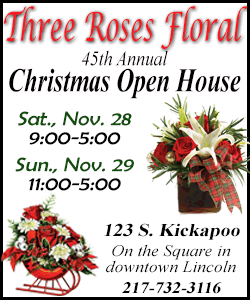|
 Area residents are being asked to contribute to this display by
donating or loaning dishes or other items relating to the Illinois
or Stetson China Co. for this display. Photographs are welcomed. Area residents are being asked to contribute to this display by
donating or loaning dishes or other items relating to the Illinois
or Stetson China Co. for this display. Photographs are welcomed.
Items may be brought to the LCGHS office at 114 N. Chicago St. from
11 a.m. to 4 p.m. on Tuesday, Nov. 17; Thursday, Nov. 19; or Friday,
Nov. 20.
In 1918 subscription Committees of the Lincoln Community Club
visited local people to seek subscriptions for the required $50,000
in stock to bring the Illinois China Co. to Lincoln from Roodhouse,
IL.
Although originally intended to erect the factory on the old brick
yard site at the South Mine, it was decided to locate the factory on
the triangular plot near where the old Illinois Central station
stood before it burned. The front entrance would face North Kickapoo
Street.

In 1919 the Illinois China Company received a lease from the
Illinois Central railroad to erect its factory on the north and
south side of the railroad property. The new location deal was
completed in March of 1919 with the Latham Estate.
C. Eastham was named architect for the building and J. Smith the
manager of the plant which was to occupy 38,000 feet of floor space.
W. H. Price, an expert sagger maker arrived from Germany and A. W.
Hawes of Zanesville, Ohio arrived to take charge of the molding and
modeling room. The making of white ware was expected to start Aug.
1.
Saggers are the pottery vessels used to bake white ware. At the time
it was anticipated the making of one cup would consume a four week
process.
The original building burned in 1922, leaving only the kilns.
Stockholders then built a new factory 50 per cent larger and began
producing decorated china. A sprinkling system was added.
In 1928 officers were David H. Harts, president; W. W. Houser, vice
president; William M. Coogan, secretary; and F. W. Longan,
treasurer.
Directors included J. W. McGrath and William Kahn with James Shaw,
general manager. The china was decorated with decal like transfers
with each band being painted by hand. The potters were members of
the National Brotherhood of Operative Potters, Local 116.
[to top of second column] |

By 1925 the Illinois China Co. was supplying china to 45
Kresge stores. It occupied 50,000 square feet of floor space and
had 80 employees.
It was in 1946 when the company was sold to the Stetson China Co. of Chicago.
Reinhold Schweikert was retained as sales manager and William Coogan as plant
manager.
J. W. Joe Stetson was a self-made man who had noticed the beehive kiln chimneys
of the plant while traveling between Chicago and St. Louis.
Stetson purchased the Lincoln plant because he wanted a steadier supply of
blanks, plain dishes, for decorating.
A modern, automated factory was built on the site at a cost of 2.5 million
dollars. A shipping, receiving, and finishing plant was built across the tracks.
A second plant was built and later sold to Pittsburgh Plate Glass Co. By 1962
the plant had expanded to 265,000 square feet, had 800 employees, and was the
largest manufacturer of hand decorated dinnerware under one roof in the world.
Towards the end of its production years Stetson sold nearly all of its wares to
a Chicago firm that resold the dishes to grocery and furniture stores which used
the dishes as customer premiums.
As foreign competition stiffened and Melmac was introduced, the factory closed
in 1965.
Among noted Stetson China Co. productions were commemorative plates in memory of
the 1908 100th and 1959 Sesquicentennial of Abraham Lincolnís birthday and the
plate featuring University Hall for the Centennial of Lincoln College.
[Diane Osborn, LCGHS]

 |